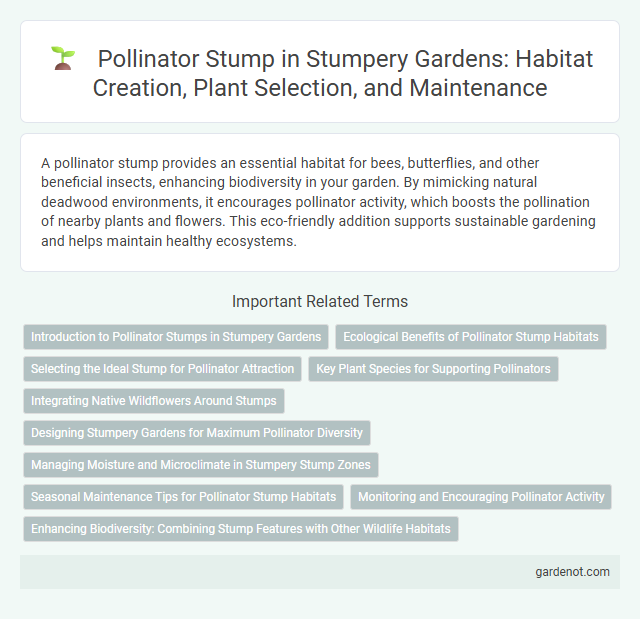A pollinator stump provides an essential habitat for bees, butterflies, and other beneficial insects, enhancing biodiversity in your garden. By mimicking natural deadwood environments, it encourages pollinator activity, which boosts the pollination of nearby plants and flowers. This eco-friendly addition supports sustainable gardening and helps maintain healthy ecosystems.
Introduction to Pollinator Stumps in Stumpery Gardens
Pollinator stumps in stumpery gardens provide essential habitats for bees, butterflies, and other beneficial insects by mimicking natural woodland conditions. These decaying wood structures retain moisture and support fungi, mosses, and lichens, creating microhabitats crucial for pollinator nesting and foraging. Incorporating pollinator stumps enhances biodiversity and promotes healthy ecosystems within garden landscapes.
Ecological Benefits of Pollinator Stump Habitats
Pollinator stumps create vital habitats that support biodiversity by providing shelter and nesting sites for bees, butterflies, and other pollinators. These decomposing wood structures promote nutrient cycling and soil health while enhancing local ecosystems' resilience to environmental changes. Integrating pollinator stumps into gardens and natural landscapes contributes significantly to sustaining pollination services essential for plant reproduction and food production.
Selecting the Ideal Stump for Pollinator Attraction
Choosing the ideal stump for a pollinator stump involves selecting decayed wood with diverse textures and crevices to provide shelter and nesting sites for bees and other pollinators. Opt for stumps from native hardwood trees like oak or maple as they support a richer range of local pollinator species due to their natural compatibility with native flora. Position the stump in sunny, sheltered areas near flowering plants to maximize its effectiveness as a vibrant habitat for pollinators.
Key Plant Species for Supporting Pollinators
Pollinator stumps integrate native wildflowers such as Echinacea purpurea, Asclepias tuberosa, and Solidago canadensis, which provide essential nectar and pollen for bees, butterflies, and other pollinators. These plants support diverse pollinator communities by offering continuous bloom periods and habitat structure critical for foraging and nesting. Incorporating these key species into stumpery designs enhances local biodiversity and promotes healthier ecosystems.
Integrating Native Wildflowers Around Stumps
Integrating native wildflowers around a pollinator stump enhances habitat complexity and supports local biodiversity by attracting essential pollinators such as bees, butterflies, and hummingbirds. Choosing species like Echinacea purpurea, Asclepias tuberosa, and Solidago canadensis promotes seasonal blooms and provides nectar and pollen throughout the growing season. This naturalistic planting strategy not only beautifies the stumpery but also fosters ecological resilience by reinforcing native plant-pollinator networks.
Designing Stumpery Gardens for Maximum Pollinator Diversity
Pollinator stumps create essential habitats by providing diverse microenvironments that support bees, butterflies, and other vital pollinators. Designing stumpery gardens involves incorporating varied wood textures, decay stages, and strategic plant companions to enhance nesting sites and forage availability. Concentrating on native pollinator species and seasonal continuity maximizes biodiversity and ecosystem resilience in these specialized garden spaces.
Managing Moisture and Microclimate in Stumpery Stump Zones
Pollinator stumps in stumperies create essential microhabitats by managing moisture retention and regulating temperature fluctuations, which support diverse insect populations. The decaying wood structure absorbs and slowly releases moisture, maintaining a stable microclimate critical for pollinator survival and activity throughout seasonal changes. Strategic placement of stumps in shaded or sheltered zones enhances humidity levels and protects pollinators from extreme weather conditions.
Seasonal Maintenance Tips for Pollinator Stump Habitats
Pollinator stump habitats require seasonal maintenance to ensure a thriving environment for bees and other beneficial insects. Remove accumulated debris and dead wood in early spring to promote new nesting sites and airflow, preventing mold growth. In late autumn, leave some hollow stems and leaf litter intact to provide winter shelter for pollinators and overwintering larvae.
Monitoring and Encouraging Pollinator Activity
Monitoring pollinator activity around a pollinator stump involves systematic observation of native bee species, butterflies, and other beneficial insects using visual counts and timed surveys. Encouraging pollinator activity is achieved by selecting decaying wood rich in fungal growths, which provides essential habitat and food resources, and by situating the stump in sunny, sheltered locations to maximize pollinator visitation rates. Regular documentation of species diversity supports adaptive management strategies to enhance habitat quality and optimize pollination services in stumpery designs.
Enhancing Biodiversity: Combining Stump Features with Other Wildlife Habitats
Pollinator stumps serve as vital microhabitats by combining natural wood decay with flowering plants, creating diverse nesting and foraging opportunities for native bees, butterflies, and other beneficial insects. Integrating these stumps with features such as wildflower meadows, log piles, and water sources amplifies habitat complexity, promoting ecosystem resilience and increased species richness. This synergy supports pollination networks essential for maintaining local biodiversity and agricultural productivity.
Pollinator stump Infographic

 gardenot.com
gardenot.com